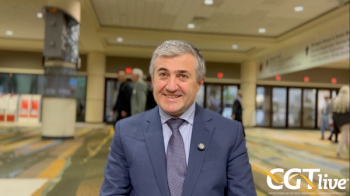
Rituximab Maintenance Prolongs Survival in Younger MCL Patients
Younger patients with mantle cell lymphoma lived significantly longer and without disease progression or clinical events when they received rituximab maintenance therapy after stem cell transplantation, final results of a randomized trial showed.
Steven Le Gouill, MD, PhD
Younger patients with mantle cell lymphoma lived significantly longer and without disease progression or clinical events when they received rituximab maintenance therapy after stem cell transplantation, final results of a randomized trial showed.
Patients randomized to rituximab maintenance had an event-free survival (EFS, primary endpoint) at 4 years of 78.9% as compared with 61.4% who did not get maintenance therapy (P = .0012). The 4-year progression-free survival (PFS) was 82.2% with rituximab maintenance and 64.6% without (P = .0005). Overall survival (OS) at 4 years was 88.7% and 81.4%, respectively, for rituximab maintenance and no maintenance (P = .0413).
The results confirmed and extended preliminary results from a previous analysis, which showed a trend toward improved EFS and PFS with rituximab maintenance, Steven Le Gouill, MD, PhD, reported at the American Society of Hematology meeting in San Diego.
“The final analysis of this trial demonstrates that rituximab maintenance after autologous stem cell transplant prolongs event-free survival, progression-free survival, and overall survival,” said Le Gouill, director of lymphoma research at Nantes University Medical Center in France. “Rituximab maintenance, administered every 2 months for 3 years should be recommended to all transplanted patients with mantle cell lymphoma.”
Rituximab maintenance therapy, after R-CHOP induction chemotherapy, has been shown to improve survival in older patients with mantle cell lymphoma.1 Standard treatment for younger patients has included high-dose cytarabine followed by consolidation with autologous stem-cell transplantation (ASCT), said Le Gouill. Whether maintenance rituximab might improve survival in younger patients after ASCT remained unclear.
To investigate the potential benefits of rituximab maintenance in younger patients with previously untreated mantle cell lymphoma, investigators at sites throughout France conducted a randomized trial involving patients younger than 66. All patients received induction therapy consisting of rituximab, dexamethasone, high-dose cytarabine, and platinum, followed by ASCT consolidation. Patients who did not attain at least a partial remission with the initial induction therapy (n = 14) received an additional 4 courses of R-CHOP prior to ASCT.
The primary endpoint was EFS, as determined from the time of randomization. Secondary endpoints included PFS and OS.
A review of baseline characteristics showed that the patients had a median age of 57, and that men accounted for 79% of the study population. By the Mantle Cell Lymphoma International Prognostic Index criteria, 53% of the patients had low-risk disease, 27.4% had intermediate-risk disease, and 19.5% had high-risk disease.
An interim analysis revealed a trend to better EFS and PFS in patients randomized to rituximab maintenance therapy, and follow-up in the trial continues.2 Le Gouill reported results after a median follow-up of 50.2 months from randomization. The analysis showed that the median EFS, PFS, and OS had yet to be reached in either treatment group.
Analysis of 4-year outcomes showed statistically significant advantages for all survival endpoints in favor of rituximab maintenance therapy. By intention-to-treat analysis, rituximab maintenance was associated with a 54% reduction in the EFS hazard ratio (HR 0.457, P = .0016), a 60% reduction in the risk of disease progression or death (HR 0.40, P = .0007), and a 50% reduction in the survival
hazard (HR 0.50, P = .0454).
References
- Kluin-Nelemans HC1, Hoster E, Hermine O, et al. Treatment of older patients with mantle-cell lymphoma. N Engl J Med. 2012;367:520-531. doi: 10.1056/NEJMoa1200920.
- Le Gouill S, Thieblemont C, Oberic L, et al. Rituximab maintenance versus wait and watch after four courses of R-DHAP followed by autologous stem cell transplantation in previously untreated young patients with mantle cell lymphoma: first interim analysis of the phase III prospective LyMa trial, a LYSA study [ASH abstract 146]. Blood. 2014;124(21 suppl).
“Thus, 4 courses of rituximab-containing induction therapy plus autologous stem cell transplant, without total body irradiation, followed by rituximab maintenance therapy for 3 years may be considered a new standard of treatment for young patients with mantle cell lymphoma,” said Le Gouill.
<<<
Patients who attained partial or complete response after ASCT were then randomized to 3 years of rituximab maintenance therapy or no additional treatment. Among 277 evaluable patients, the overall response rate was 89.3%, including confirmed and unconfirmed complete response in 77.3%. Subsequently, 257 patients completed ASCT consolidation, and 240 of those underwent randomization and were included in the data analysis.
Newsletter
Stay at the forefront of cutting-edge science with CGT—your direct line to expert insights, breakthrough data, and real-time coverage of the latest advancements in cell and gene therapy.

















































